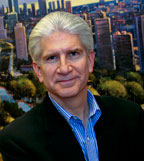 |
| Bio |
| Resume |
| Exhibits |
| Publications |
| Media |
| Steve Immerman crafts colorful career in glass | |
When Steven C. Immerman, MD '77, GME '82, of Eau Claire, Wisconsin, was a child growing up in the suburbs of New York City, he knew that he wanted to become a physician. And after his first year as a medical student at Northwestern, he knew without a doubt that surgery was the specialty he would pursue. What he did not know is that nearly 30 years after medical school he would be a successful glass artist whose work would be shown side by side with that of such masters as Dale Chihuly. Dr. Immerman's love affair with glass had romantic beginnings. He and wife Eileen, a 1977 graduate of the Wesley-Passavant School of Nursing (they met at Passavant when he was a third-year medical student), were on their honeymoon in Canada in 1979 when they came across an antiques store selling stained glass windows from an estate. Struck by their beauty, they bought the windows. "Some of the windows were broken, so I had to figure out how to fix them," says Dr. Immerman. "In the process, I learned how to make stained glass windows. During residency I had a little room set up in our apartment where I would make them. Even when I was relaxing from surgery, I liked working with my hands." After residency and a one-year fellowship in surgical oncology at Evanston Hospital, he moved to Eau Claire, Wisconsin, a city of 62,000 in west-central Wisconsin, and opened an independent, solo practice that has since grown to include two partners. How the New Yorker became a resident of the Dairy State is directly linked to serendipity, friendship, and the medical school. "My roommate from medical school, Stephen [D.] Cook [MD '76] was from this area. We came up here several times as students, and I thought it would be nice place to live and practice," says Dr. Immerman, "and that's been it for the last 25 years." Friendships struck during medical school continue today. Dr. Cook is an emergency room physician at the hospital where Dr. Immerman performs surgery, and another medical school pal, Peter W. Holm, MD '77, one of Dr. Immerman's anatomy lab partners, is an ophthalmologist in nearby Chippewa Falls. "The three of us very much wanted to live near each other," he recalls. Dr. Immerman felt comfortable in the small city immediately, he says. Over the next 10 years the hectic pace of an independent practice as well as a young family of three active sons (Douglas, now 21; Andrew, 17; and Matthew, 16) didn't leave much time for glasswork. But in the nineties he felt compelled to return to the art form. Professionally, it was a decade of challenges. "Eau Claire is very competitive in terms of health care. Our competitors—Mayo Clinic and Marshfield Clinic—are highly organized physician groups. When I opened my practice, neither was involved in the business of this town. Then one of the nearby independent clinics was taken over by Mayo Clinic. In the early nineties it became clear that unless we could level the playing field as independent physicians, we wouldn't be able to survive," states Dr. Immerman. text continues in column to right |
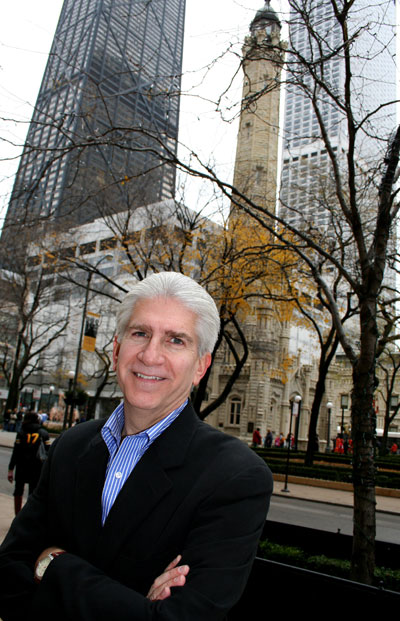
Chicago holds a special place in the heart of surgeon Dr. Steve Immerman. It's here he met wife Eileen and chums Drs. Steve Cook and Peter Holm and where he first began working in glass. Photo by Jim Ziv, Chicago In 1993 he founded Oak Leaf Medical Network, an organization of independent physicians that helps its members with activities such as marketing, contracting, and recruitment. Oak Leaf has grown from 60 physicians to 180 today. The successful group built an ambulatory surgery center that recently was expanded and relicensed as a surgical hospital. Dr. Immerman is proud of the group's success at keeping the independent practice of medicine thriving in Eau Claire (which translates to "Clear Water" in French) and surrounding areas. "Around the time that I started Oak Leaf," he says. "I realized I needed to find that creative outlet again and wanted to go back to glasswork." He considered glass blowing, but it didn't seem feasible. "It requires a large studio and possibly a helper, and you couldn't stop in the middle to answer a pager," he explains practically. He turned instead to kilnformed glass, in which sheets and strips of glass are melted and shaped in a kiln (1500 degrees Fahrenheit for many of Dr. Immerman's pieces) rather than in a furnace or with a torch. "I started researching it, and it seemed like something I could do at home," he says. |
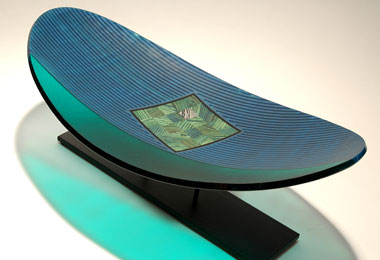 |
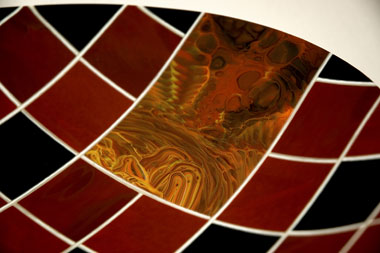 |
| Dr. Immerman's kilnformed glass pieces include Eleuthra (left) and Solar Meridian (right). Most of his pieces sell for between $1000 and $4000.
|
|
Dr. Immerman began working in the art form in 1995, spending the first five or six years purely experimenting. To build on his repertoire of techniques, he would take a week here and there to attend classes at different locales around the country. "At first, my goal was to see how many techniques I could apply to an individual piece and still have it be attractive," he says. "Now I'm trying to make pieces that are simple and straightforward, have some sort of message, and are beautiful." The surgeon's Clearwater Glass Studio (www.clearwaterglass.com) consists of two medium-sized, "cramped" rooms in the basement of his home that hold two kilns (the shelf on his larger kiln measures 22" X 22") and numerous tools that enable him to grind edges smooth, sandblast finishes, and remove bubbles and fingerprints that can ruin a piece. "For the first seven years I didn't have any of these tools and had just one shot to get it right," he says. "That period taught me a lot." At any given time, between one and three pieces are in progress, with each taking two weeks or more to complete. Dr. Immerman anguishes over the design of each piece, but relishes the six to eight hours spent assembling the piece by hand. "Putting it together, which is often tedious—upward of 200 strips of glass may have to be cut and fit together—is the part I enjoy most," he relates. The piece then is fired in the kiln for 15–20 hours, cooled, and put through 3 or 4 hours of "coldworking," which may include grinding the edges to a precise oval or sandblasting it to produce a texture. Then it may be returned to the kiln for a 20-hour cycle of "firepolishing" and sandblasted and reshaped again. Says Dr. Immerman with a laugh, "I often know that it's a successful piece when I bring it upstairs to show to my wife, and she says, 'You're not going to sell that one , are you?'" But his pieces do sell, typically for between $1,000 and $4,000. He's as surprised as the next guy. "I had planned on this being a hobby that would have me puttering around in the basement, making ashtrays," he says modestly, "but all of a sudden it took off." |
He gives the Internet—specifically, a bulletin board for artists working in kilnformed glass— much credit for his success. He met fellow artists, learned about and attended classes that improved his skills, networked with artists whose works were being sold in galleries, and found out from those artists that yes, his work was good enough to be sold in a gallery. "Without the Internet," he says, "I don't know how any of this would have happened." Dr. Immerman's pieces are sold at Pismo Fine Art Glass, a gallery with four locations in Colorado. "It represents some of the biggest names in glass art in the country, and I'm selling pieces. That means that people are walking into the gallery and amongst this array of absolutely fantastic glass artwork are occasionally deciding that the piece they want to walk out with is mine!" he says in awe. Particularly special in Dr. Immerman's life as a glass artist was an event held in fall 2006, the Pilchuk Glass School charity auction in Seattle. The Pilchuk School was founded by world renowned blown glass artist Dale Chihuly, and proceeds from the annual auction support the school. The event includes both a silent and live auction, with the live auction being the more prestigious of the two. Of the 350 pieces submitted, Dr. Immerman's was one of 75 to be selected for the live auction. Recalls the surgeon with utter amazement, "In the gallery where it was being displayed, it was sitting right next to a Chihuly, [Lino] Tagliapetra [a master Italian glass blower], and Dante Marioni [a well-respected American glass artist]. These are the most famous glass blowers in the world, and my piece was stuck in this cluster amongst them. To me it didn't belong, but it was thrilling." Laura Bleiler |
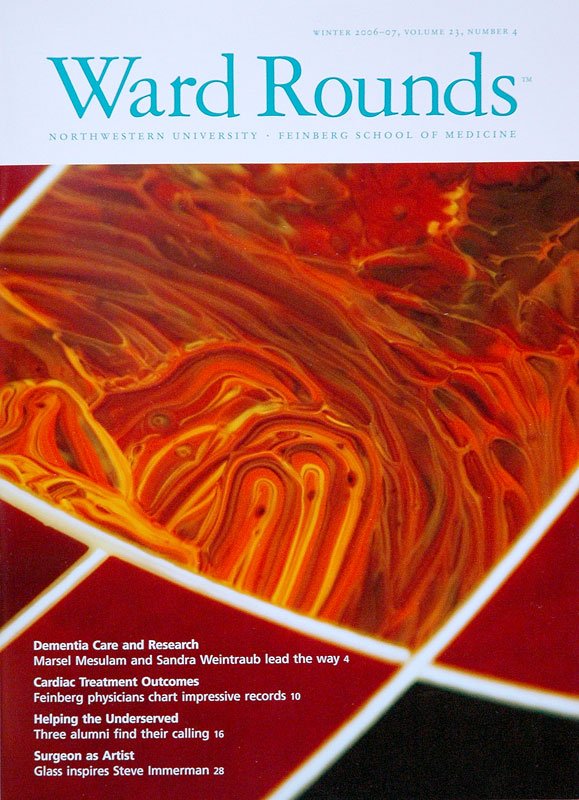 |
ON THE COVER
Beautiful things can happen to glass when heated to 1,500 degrees Farehheit. In his Clearwater Glass Studio in Eau Claire, Wisconsin Dr. Steve Immerman produces art such as this piece, Solar Meridian, in a medium called kilnformed glass. Turn to page 28 to learn how this practicing surgeon is developing a second career as an artist. Copyright 2007 Northwestern University. From Ward Rounds, the magazine of the Feinberg School of Medicine. Article and photos may not be reproduced without permission. E-mail requests to ward-rounds@northwestern.edu. Winter 2006-2007. Photos by Steve Immerman, except as otherwise indicated. |